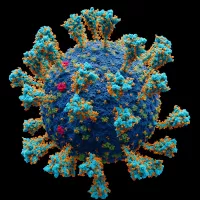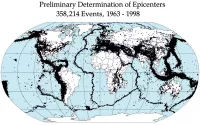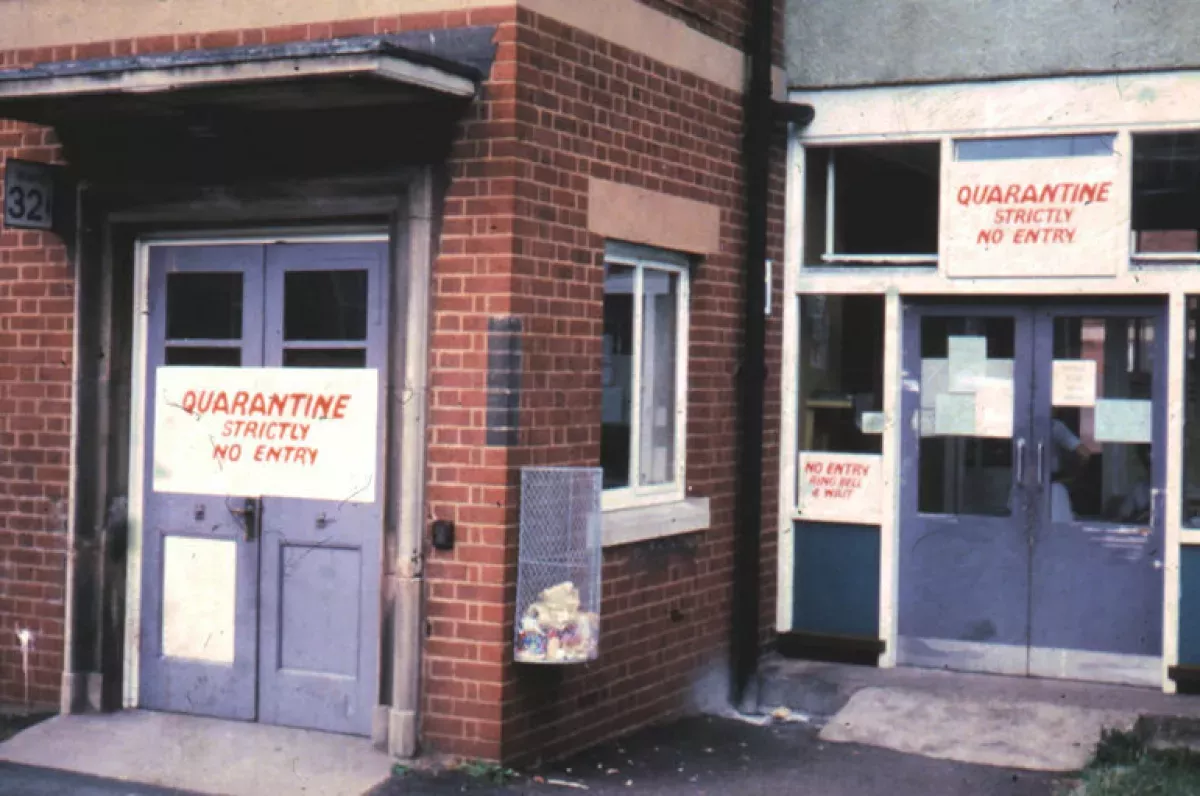Quarantine is the restriction of movement for people, animals, and goods to prevent the spread of disease or pests. It primarily applies to individuals who may have been exposed to a communicable disease but lack a confirmed diagnosis, distinguishing it from medical isolation, where diagnosed individuals are separated from the healthy population. Quarantines aim to control the potential spread of diseases by limiting the movement of potentially infected entities.
1901: Plague Epidemics in Honolulu and San Francisco
The plague epidemics that affected Honolulu and San Francisco concluded in 1901, following the implementation of quarantine and other public health measures.
December 1903: Additional Paris Convention on Plague
An international convention addressing the plague outbreak in the East was signed in Paris in December 1903, focusing on collaborative international measures to prevent the disease's spread.
June 1904: Rio de Janeiro Sanitary Convention
A regional sanitary convention was held in Rio de Janeiro in June 1904, marking a collaborative effort in Latin America to address infectious diseases.
1907: Mary Mallon's First Isolation
In 1907, Mary Mallon was forcibly isolated due to being a typhoid carrier.
1907: Mary Mallon Quarantined
In 1907, Mary Mallon, a cook identified as a carrier of Salmonella enterica (typhoid fever), was quarantined under the Greater New York Charter.
1907: Quarantine of Typhoid Mary
In 1907, Mary Mallon, known as "Typhoid Mary," was quarantined due to her status as a typhoid fever carrier, raising significant questions about civil rights in the context of quarantine measures.
1910: Mary Mallon's Initial Release
In 1910, Mary Mallon was released from her initial forced isolation.
January 1912: Multilateral International Sanitary Convention in Paris
A comprehensive multilateral international sanitary convention took place in Paris in January 1912, aiming to supersede previous conventions on international health regulations.
October 1914: Uruguayan Ratification of 1914 Convention
Uruguay ratified the Montevideo sanitary convention in October 1914, formally adopting its provisions for disease control.
September 1917: Paraguayan Ratification of 1914 Convention
Paraguay ratified the Montevideo sanitary convention in September 1917, formally joining the regional effort to combat infectious diseases.
1918: Quarantines During 1918 Flu Pandemic
During the 1918 flu pandemic, quarantines were implemented to control the spread of the disease.
1918: Protective Sequestration during 1918 Flu Pandemic
During the 1918 influenza pandemic, the concept of "protective sequestration" or "reverse quarantine" emerged, focusing on isolating healthy individuals to protect them from infection. New quarantine standards extending to public spaces also became common, including isolation, surveillance, and the closure of schools, churches, theaters, and public events.
October 1920: Ratification of 1912 Paris Convention
In October 1920, ratifications for the 1912 Paris international sanitary convention were exchanged, marking its official adoption by several signatory countries.
January 1921: Brazilian Ratification of 1914 Convention
Brazil ratified the Montevideo sanitary convention in January 1921, completing the set of ratifications by the participating countries.
June 1922: Soviet-Latvian Sanitary Convention
In June 1922, a sanitary convention was signed between Soviet and Latvian governments, establishing a bilateral agreement for disease control.
July 1922: Latvia-Poland Sanitary Convention
A bilateral sanitary convention was signed between Latvia and Poland in July 1922, promoting collaborative efforts for disease management.
July 1923: Ratification of Poland-Romania Convention
Ratifications were exchanged for the Poland-Romania sanitary convention in July 1923, marking the official adoption of the agreement.
October 1923: Ratification of Soviet-Latvian Convention
Ratifications for the Soviet-Latvian sanitary convention were exchanged in October 1923, putting the agreement into effect.
January 1924: Ratifications Exchanged for Poland-Soviet Convention
Ratifications were exchanged for the sanitary convention between Poland and the Soviet government in January 1924, putting the bilateral agreement into effect.
April 1925: Ratification of Latvia-Poland Convention
Ratifications for the Latvia-Poland sanitary convention were exchanged in April 1925, formally enacting the agreement.
September 1925: Poland-Czechoslovakia Sanitary Convention
Poland and Czechoslovakia signed a sanitary convention in September 1925, adding another layer to the network of bilateral health agreements.
1925: Diphtheria Outbreak and Serum Run to Nome
During 1925, a diphtheria outbreak prompted the serum run to Nome, Alaska, highlighting the use of quarantine measures alongside medical intervention.
June 1926: Multilateral Convention in Paris
A multilateral convention was signed in Paris in June 1926, intended to replace the 1912 convention and update international sanitary regulations.
July 1926: Germany-Latvia Sanitary Convention
Germany and Latvia signed a sanitary convention in July 1926, further expanding their bilateral health cooperation.
October 1926: Ratifications for Poland-Czechoslovakia Convention
Ratifications for the Poland-Czechoslovakia sanitary convention were exchanged in October 1926, signifying the formal adoption of the agreement.
July 1927: Ratifications for Germany-Latvia Convention
Ratifications were exchanged for the Germany-Latvia sanitary convention in July 1927, officially putting the agreement into force.
1938: Mary Mallon's Death and Autopsy
In 1938, Mary Mallon died, and an autopsy confirmed the presence of Salmonella bacteria in her gallbladder. She had spent a total of 26 years in isolation.
1944: Public Health Service Act of 1944
The 1944 Public Health Service Act established federal quarantine authority, tasking the US Public Health Service with preventing communicable disease spread from foreign countries. It expanded authority to incoming aircraft and allowed detention of individuals reasonably believed to be infected.
1957: 1957-58 Influenza Pandemic
During the influenza pandemic of 1957-58, various countries implemented control measures, alongside the establishment of a global influenza surveillance network by the World Health Organization.
1963: Suspected Smallpox Case Quarantine
In 1963, a suspected smallpox case led to quarantine measures being invoked. Since the 1918 pandemic, federal and local quarantine statutes have been used infrequently.
1963: End of Federal Quarantine Orders (Until 2020)
No federal quarantine orders were issued in the US from 1963 until 2020, when citizens were evacuated from China during the COVID-19 pandemic.
1968: 1968 Flu Pandemic
In 1968, the flu pandemic prompted international efforts to control the spread, showcasing the continuing evolution of global disease management strategies.
1972: Yugoslav Smallpox Outbreak
A smallpox outbreak struck Yugoslavia in 1972, leading to quarantine measures being employed to control the spread of the disease.
1984: Siracusa Principles Adopted by UN
In 1984, the United Nations Economic and Social Council adopted the Siracusa Principles, a document providing guidance on restricting human rights to prevent infectious disease spread. The principles emphasize legality, necessity, proportionality, and gradualism for restrictions, stating that public health can justify limiting certain rights if measures are "strictly necessary" to prevent disease or provide care.
1994: Plague in India and Quarantine Measures
In 1994, a plague outbreak in India led to quarantines and fumigation of vessels and aircraft to prevent disease spread.
2000: UK Abolishes Pet Quarantine
In 2000, the United Kingdom abolished its six-month quarantine requirement for imported animals, replacing it with the Pet Passports scheme, allowing animals with proper vaccination documentation to avoid quarantine.
February 2003: Steve Urbon on Temporary Quarantine Powers
On February 2003, Standard-Times senior correspondent Steve Urbon described temporary quarantine powers.
March 2003: HazMat Magazine Quarantine Guidance
In March 2003, HazMat Magazine suggested locking individuals in a room until decontamination could be performed in cases of suspected anthrax exposure.
2005: Quarantine Act Rewrite in Canada
In 2005, Canada rewrote its Quarantine Act. Three acts regulate quarantine: the Quarantine Act for humans, the Health of Animals Act, and the Plant Protection Act. The Governor in Council can prohibit imports during health emergencies under the Quarantine Act.
2007: Andrew Speaker Case
In 2007, Andrew Speaker's case of multi-drug-resistant tuberculosis brought the practice of quarantining individuals suspected of carrying infectious diseases into the spotlight.
2008: Cost Estimates for Larger Quarantine Facilities
In 2008, the Airport Cooperative Research Program (ACRP) published cost estimates for establishing temporary, larger quarantine facilities to house 100-200 travelers for several weeks.
2014: US Executive Orders on Quarantine
As of 2014, Executive Orders 13295, 13375, and 13674 specify communicable diseases authorizing apprehension, detention, or conditional release of individuals in the US. The latest order lists diseases like cholera, diphtheria, tuberculosis, plague, smallpox, yellow fever, viral hemorrhagic fevers, SARS, and novel influenza.
2014: CDC Quarantine Facilities at US Ports of Entry
In 2014, the CDC's Division of Global Migration Health operated small quarantine facilities at a land crossing in El Paso, Texas, and 19 international airports. Each station manages potential infections entering through its assigned region.
2014: Kaci Hickox Case
The case of Kaci Hickox in 2014, involving Ebola, sparked discussions and controversies around quarantine procedures for potentially infected individuals.
September 2015: US Quarantine Authority for Imports and People
As of September 2015, The United States can quarantine imported products linked to contagious diseases or if the disease appears elsewhere. Title 42 U.S.C. §§264 and 266 grant the Secretary of Health and Human Services authority to control movement of people during peacetime and wartime to prevent disease spread.
2015: Biosecurity Act 2015 in Australia
In 2015, Australia enacted the Biosecurity Act 2015, governing biosecurity measures. The Department of Agriculture, Water and the Environment (DAWE) is responsible for border inspections and risk assessments. Non-compliant visitors may face fines or imprisonment.
2015: Australian Biosecurity Act
The Australian Biosecurity Act of 2015 was enacted, outlining legal frameworks that encompass quarantine measures within a wider biosecurity context.
2016: Western African Ebola Virus Epidemic Management
In 2016, the Western African Ebola virus epidemic was tackled through isolation wards for infected patients and self-quarantine for potentially exposed individuals. The effectiveness of international travel restrictions was also debated.
March 2017: CDC Quarantine Regulations Update
As of March 2017, the Centers for Disease Control and Prevention (CDC) updated its regulations regarding quarantine procedures.
2019: Coronavirus Disease 2019 Pandemic Begins
The coronavirus disease 2019 pandemic began in 2019, marking a pivotal moment in global health and setting the stage for widespread quarantine measures.
2020: COVID-19 Pandemic and US Evacuations
In 2020, the COVID-19 pandemic prompted the first issuance of federal quarantine orders in the US since 1963, as American citizens were evacuated from China.
2020: Global COVID-19 Pandemic Quarantines
The COVID-19 pandemic, starting in 2020, saw extensive quarantines implemented worldwide, marking a historical moment in global health management.
Mentioned in this timeline

Coronaviruses are a family of RNA viruses affecting mammals and...
India officially the Republic of India is a South Asian...

San Francisco is a major commercial financial and cultural hub...
Germany officially the Federal Republic of Germany is a Western...
China officially the People's Republic of China PRC is an...
Australia officially the Commonwealth of Australia encompasses the Australian mainland...
Trending

6 months ago LaVar Ball Urges Clippers to Trade for LaMelo; Sends Message to NBA.

20 days ago Earthquake Rattles Northern California on Thanksgiving: Santa Rosa Area Sees 3.3 Magnitude

Jaylen Wells is an American professional basketball player currently with the Memphis Grizzlies in the NBA He transitioned to the...

9 months ago Yoel Romero Competes in Dirty Boxing at DBX 1, Hylton Fight Results
24 days ago AS Monaco's Lineup Against Pafos: Golovin Starts, Fati and Pogba on Bench.

5 months ago Sean Penn Spotted Dining with Nick Nolte and Josh Brolin in Malibu.
Popular

Candace Owens is an American conservative political commentator and author...

Tucker Carlson is an American conservative political commentator known for...

XXXTentacion born Jahseh Dwayne Ricardo Onfroy was a controversial yet...

Ben Shapiro is a prominent American conservative political commentator media...

Kashyap Pramod Patel is an American lawyer who became the...

William Franklin Graham III commonly known as Franklin Graham is...
